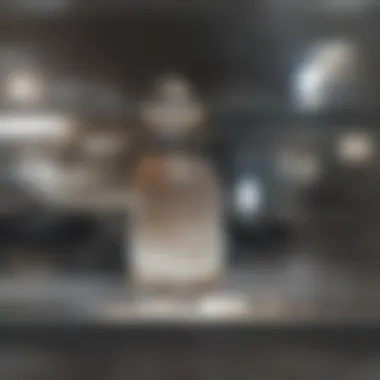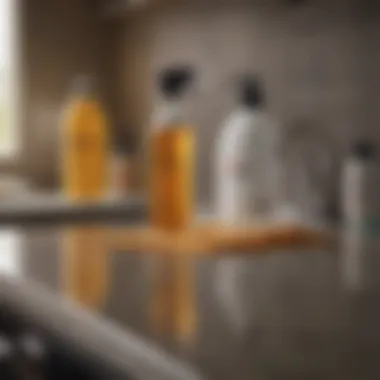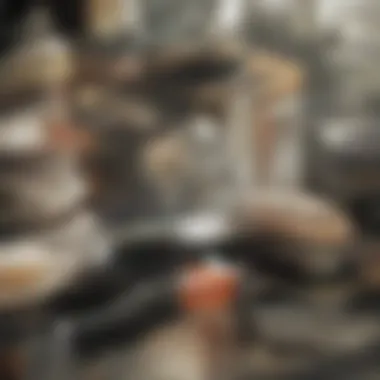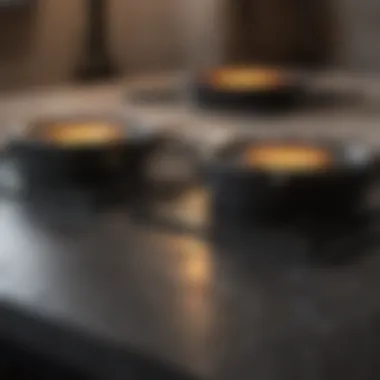Essential Cleaning Products for Ceramic Stove Tops


Intro
Ceramic stove tops are a popular choice for modern kitchens, blending aesthetics with functionality. However, they demand careful attention when it comes to cleaning. In this guide, we will explore the cleaning products specifically formulated for these surfaces. Understanding the unique qualities of ceramic stove tops is essential for maintaining their sleek appearance and extending their lifespan.
It is important to select the right products tailored for ceramic materials. Harsh cleaners can cause scratches or damage, which compromises their look and usability. Therefore, we will evaluate a variety of effective cleaning solutions available in the market. Practical tips will be shared to maximize the efficacy of these products and ensure a pristine cooking environment.
By the end of this article, readers will gain insights into the best practices for ceramic stove top maintenance. Whether you are a homeowner looking to preserve your kitchen's investment or simply an enthusiast eager to learn, the information will be invaluable.
Let's delve into specific cleaning products designed for ceramic surfaces.
Understanding Ceramic Stove Tops
Ceramic stove tops have become increasingly popular in modern kitchens, catching the eye of homeowners due to their sleek design and efficient cooking capabilities. Understanding the basic features and functions of these surfaces is essential. This section delves into their material composition, advantages, and the unique challenges they present in terms of cleaning and maintenance.
Material Composition
Ceramic stove tops are typically made from a reinforced glass-ceramic material, which is adept at handling high temperatures while being aesthetically pleasing. The materials used offer a smooth, durable surface that ensures good heat distribution. Knowing the composition helps in selecting appropriate cleaning methods. Some may assume that any cleaning product is safe, but that is not the case. Using abrasive materials or corrosive chemicals can lead to a decline in the surface finish, making it easier for stains and marks to develop.
Advantages of Ceramic Stove Tops
The significance of ceramic stove tops lies in their advantages compared to traditional metal burners. They generally provide a more even cook, with better heat retention. Additionally, their flat surface makes them easier to clean. Here are key benefits:
- Aesthetic Appeal: They provide a modern look that fits various kitchen styles.
- Ease of Use: Controls and heat levels are easy to manage.
- Energy Efficiency: They heat up quickly, promising shorter cooking times.
These attributes make ceramic stove tops an appealing choice for many.
Challenges in Cleaning and Maintenance
Despite their advantages, ceramic stove tops do face certain challenges when it comes to cleaning. One of the primary issues is the susceptibility of the surface to scratches if improper cleaning techniques or tools are used. Additionally, burned food remnants can stick severely, sometimes requiring special products to address these stains. The cleaning process must be approached with care, as using the wrong type of cleaner can lead to more damage.
Maintaining the shine and clarity of ceramic surfaces requires routine maintenance, along with selecting the right cleaning products. Knowing these challenges provides a clearer perspective on the importance of using appropriate cleaning solutions, a point extensively discussed in subsequent sections.
The Importance of Choosing the Right Cleaning Products
Choosing the right cleaning products for ceramic stove tops is a critical aspect that significantly impacts their longevity and performance. Ceramic surfaces are distinctive, combining aesthetic appeal with practical functionality. However, they are also sensitive to certain materials commonly found in cleaning products. Therefore, understanding these nuances can prevent not only cosmetic issues but also serious damage.
The benefits of selecting suitable cleaning solutions extend beyond surface cleanliness. Appropriate cleaners help maintain the shiny appearance of the ceramic surface and ensure that any residues do not pose risks to health. Considering that the stove top is a food preparation area, the repercussions of utilizing harsh chemicals can harm both the appliance and those using it.
Impact of Harsh Chemicals
The impact of harsh chemicals on ceramic stove tops cannot be understated. Many conventional cleaning products contain ingredients that can be too abrasive, leading to permanent scratches and dulling of the surface's finish. Products with strong acids or bases can etch the ceramic over time, resulting in a compromised top that looks unsightly and may harbor bacteria.
Additionally, residues from these cleaners can transfer to food. This situation can be avoided by choosing milder formulations specifically designed for ceramic surfaces. As a cleaning strategy, it is advisable to conduct research on the ingredients in products before purchase. Knowledge of chemical composition is instrumental in avoiding unwanted outcomes.
Potential Damage to Ceramic Surfaces
Ceramic surfaces are intended to withstand high temperatures and resist moisture. However, they are not impervious to damage from inappropriate cleaning methods and products. Using abrasive pads or scrubbing agents can lead to scratches and can ruin the smooth surface. Long-term exposure to certain chemicals can cause discoloration or other irreversible damage. This context highlights the necessity of using products that are pH balanced and specially formulated for ceramics.
Homeowners should always read label instructions carefully. This practice ensures that the cleaning methods align with the specific requirements of ceramic products. Not only does this lead to better aesthetic results, but it also prolongs the life of the stove top, saving both effort and cost in the long run.
In summary, selecting the right cleaning products for ceramic stove tops protects both the material and users' health, ensuring a sustainable and effective cleaning routine.
Choosing wisely is essential for maintaining the integrity of ceramic stove tops, making this knowledge vital for homeowners and cooking enthusiasts alike.


Types of Cleaning Products for Ceramic Stove Tops
Cleaning ceramic stove tops requires an understanding of the different cleaning products available. Each type of cleaning solution has its own unique formulation and purpose, which can affect the efficiency of cleaning and the safety of the ceramic surface. This section outlines the primary cleaning products that can be used on ceramic stove tops, offering insights into their benefits and considerations. Understanding these products helps homeowners make informed choices, ensuring that their stove tops remain in good condition and free from damage.
Liquid Cleaners
Liquid cleaners are among the most commonly used products for ceramic stove tops. They typically contain surfactants that help break down grease and grime, making the cleaning process more effective. The advantages of liquid cleaners include their ease of application and the ability to penetrate stubborn stains.
Many liquid cleaners are designed to be used directly on the surface or with a cloth for wiping. When selecting a liquid cleaner, consider checking for pH-balanced formulas to avoid damage to the ceramic surface. Some of the popular liquid cleaners include brands like CeramaBryte and Weiman.
Cream Cleaners
Cream cleaners offer a different approach to cleaning ceramic stove tops. They are often thicker than liquid cleaners, allowing for a more controlled application. Cream-based products can provide a slight abrasive effect, which is useful for removing tougher stains without scratching the surface.
When choosing a cream cleaner, it's essential to pick one that is specifically designed for ceramic surfaces. Products like Bar Keepers Friend and Zep offer effective cream formulations. However, it is crucial to rinse thoroughly after use to prevent any residue buildup.
Wipes and Sprays
Wipes and sprays are convenient cleaning options for quick maintenance of ceramic stove tops. Wipes are pre-soaked with a cleaning solution and are easy to use, making them suitable for daily cleaning. Sprays can be applied directly to the surface and wiped away, providing flexibility in application.
Even though they are user-friendly, be cautious with the ingredients in these products. Look for wipes and sprays that are safe for ceramic surfaces to avoid causing long-term damage. Brands like Method and Seventh Generation are popular choices for eco-friendly wipes and cleaners.
Homemade Cleaning Solutions
For those interested in cost-effective and eco-friendly options, homemade cleaning solutions can be an excellent alternative. Common household items such as vinegar and baking soda can be combined to create a natural cleaner.
To create a cleaning paste, mix equal parts of baking soda and water, applying it directly to the stained areas. Let it sit for a few minutes before wiping it away. This method can effectively remove stains while being gentle on ceramic surfaces.
Using homemade solutions not only saves money but also reduces exposure to harsh chemicals found in some commercial products.
Always remember to test any new cleaning solution on a small, inconspicuous area before applying it to the entire surface.
Choosing the right type of cleaning product for ceramic stove tops can enhance the cleaning process and maintain the surface's durability. Liquid cleaners, cream cleaners, wipes, sprays, and homemade solutions each offer unique benefits. Understanding these different options will aid in keeping ceramic stove tops looking pristine.
Evaluating Cleaning Products
Evaluating cleaning products for ceramic stove tops is essential to ensure the longevity and appearance of the surfaces. The right choice can help maintain the glossy finish and functional integrity of the stove top. Understanding what to look for when selecting a cleaning product benefits users by preventing damage and enhancing performance. Key elements include checking the formulation, compatibility with ceramic materials, and overall effectiveness against common stains or marks.
Key Ingredients to Look For
When evaluating cleaning products, it is crucial to recognize ingredients that contribute positively to the cleaning process. Products generally contain a mixture of surfactants, enzymes, and solvents
- Surfactants: These reduce surface tension, enabling the cleaning solution to spread and penetrate stains effectively. They dislodge grease and other residues.
- Enzymes: Often included in eco-friendly products, enzymes break down organic stains, making removal easier without the need for harsh abrasives.
- Mild Solvents: Solvents like isopropyl alcohol or citric acid assist in breaking down stubborn residues without harming the ceramic surface.
Users should be wary of phosphates and harsh chemicals, which can damage the ceramic finish over time. Reading labels and choosing products with safe, effective ingredients is the first step in maintaining your ceramic stove top’s pristine condition.
pH Balance and Its Significance
The pH balance of a cleaning product is another significant aspect to consider. A balanced pH ensures that the cleaner is neither too acidic nor too alkaline, both of which can damage ceramic surfaces.
- Neutral pH (around 7): Cleaning products with a neutral pH are safe for ceramic stove tops, preventing etching or discoloration.
- Acidic Products: These may be effective for tough stains but can corrode the surface over time, leading to a dull appearance.
- Alkaline Cleaners: While good for tackling grease, they can also cause damage if used excessively or improperly.
A good rule of thumb is to choose products specifically labeled as safe for ceramic materials, as they are likely formulated to maintain the right pH balance for optimal care.
By considering these factors—key ingredients and pH balance—one can make informed decisions when selecting cleaning products for ceramic stove tops, ensuring that their surface remains in excellent condition for years to come.


Top Recommended Cleaning Products for Ceramic Stove Tops
In this section, we highlight the importance of selecting the right cleaning products for ceramic stove tops. The effectiveness of a cleaning product can vary greatly, making it crucial to choose wisely. Various products available on the market cater specifically to ceramic surfaces, ensuring that they clean effectively without causing any harm. High-quality cleaners not only simplify the cleaning process but also help maintain the aesthetics and functionality of the stove top.
When selecting cleaning products, it is essential to consider factors like the ingredients, the pH level, and how they compare to other solutions. Using the right product can prevent scratches, discoloration, or other damage that may result from inappropriate cleaners. In essence, the right cleaning product preserves the longevity of your ceramic stove top.
Product Reviews
For an informed decision, we review some of the top recommended cleaning products designed for ceramic stove tops. Each product is rated based on effectiveness, ease of use, and safety features:
- Cerama Bryte Cooktop Cleaner
This cleaner is well-known for its gentle yet effective formula. It helps in removing tough burnt-on stains while leaving no residue. Users praise its ease of use, requiring no extra scrubbing to achieve a sparkling finish. - Weiman Cook Top Cleaner and Polish
This all-in-one product not only cleans but also polishes ceramic surfaces. The formula protects against future stains, making it a popular choice for those looking to maintain their stove tops long-term. - Bar Keepers Friend Cooktop Cleaner
Renowned in the cleaning industry, this product expertly handles tough stains and burnt food remnants. Its biodegradable formula is also a plus for eco-conscious consumers. - Sunny & Honey Natural Stovetop Cleaner
As a non-toxic option, this cleaner is ideal for households with children or pets. It delivers powerful cleaning without harsh chemicals, offering a balance between safety and effectiveness. - Stardrops The Pink Stuff
Although not marketed solely for ceramic stove tops, this multipurpose cleaner has received rave reviews for its performance on various surfaces, including ceramics. Its abrasive formula is effective in tackling tough spots but should be used with care to avoid scratches.
Comparative Analysis
To assist users in making the best choice, a comparative analysis of the reviewed products highlights their characteristic strengths and weaknesses:
| Product | Effectiveness | Safety | Ease of use | Price | | Cerama Bryte Cooktop Cleaner | High | Safe for all | Easy | Moderate| | Weiman Cook Top Cleaner and Polish| High | Non-toxic | Very easy | Moderate| | Bar Keepers Friend Cooktop Cleaner| Very High | Mildly abrasive | Moderate | Budget | | Sunny & Honey Natural Cleaner | Moderate | Very safe | Easy | Higher | | Stardrops The Pink Stuff | High | Safe with care | Easy | Budget |
This table presents a clear overview for comparison, allowing readers to weigh their options effectively based on the specific needs of their ceramic stove tops. By understanding the pros and cons featured in these top recommended cleaning products, discerning homeowners can ensure they invest in the right solutions for maintaining their kitchen's aesthetics and functionality.
Cleaning Techniques for Optimal Results
When dealing with ceramic stove tops, employing the right cleaning techniques is key to ensuring their longevity and aesthetic appeal. These surfaces tend to scratch easily and can harbor stains if not cleaned properly. Thus, understanding the best methods for application helps in maintaining the stove top in pristine condition. Also, it reduces wear and tear that may occur over time due to improper cleaning methods. Thus, mastering these techniques leads to both immediate and long-term benefits.
Proper Application Methods
Using effective application methods can greatly influence the outcome of your cleaning routine. First and foremost, always start with a cool surface. Cleaning hot stove tops risks burns and can damage cleaning products.
To clean effectively:
- Choose the right product. For instance, use a cream cleaner or liquid cleaner designed for ceramic surfaces. Avoid harsh scouring pads.
- Dampen a soft cloth or sponge. This helps to lift grime without scratching the surface.
- Apply the cleaner evenly. Start from the center and move outward. This prevents cleaning solution from dripping onto other parts of the stovetop.
- Gently scrub any tough stains without applying excessive pressure.
After scrubbing, rinse the area with a damp cloth to remove any cleaner residue. Finally, wipe with a dry, soft cloth to enhance shine. This helps avoid streaks and keeps the surface looking new.
Avoiding Scratches and Damage
Scratching is a common concern with ceramic stove tops, and addressing this issue is vital for their upkeep. To avoid scratches:
- Use soft cleaning tools. Microfiber cloths or non-abrasive sponges are preferred. These types of materials do not scratch delicate surfaces.
- Avoid abrasive cleaners. Products like baking soda, while effective, can be too abrasive and damaging. Choose specifically formulated cleaners instead.
- Be cautious with cookware. Heavy or rough-bottomed pots and pans can cause unintentional scratches. Always lift rather than slide cookware on the surface.
- Regularly check for debris. Before cleaning, inspect the countertop for any loose particles that could scratch the surface when wiped.
"Preventive care is crucial. Scratch prevention is always more manageable than damage repair."
By following these recommendations, homeowners can maintain the aesthetic integrity and functionality of their ceramic stove tops. Each technique ensures not only cleanliness but also preservation, thus enhancing the overall cooking experience.
Preventive Maintenance for Ceramic Stove Tops
Preventive maintenance is vital for maintaining the appearance and longevity of ceramic stove tops. Regular care not only helps in preserving the shine but also minimizes the risk of tough stains and scratches. By adopting a proactive approach, homeowners can save time and costs associated with intensive cleaning later on.
An effective preventive maintenance routine should focus on consistency. Routine cleaning practices ensure that debris and residue do not accumulate, which often leads to stubborn stains. It is essential to clean spills immediately, as allowing them to sit can result in more significant problems over time.
Additionally, preventive maintenance can enhance the overall performance of the stove top. Residue build-up can affect heating efficiency, leading to longer cooking times and increased energy consumption. Through regular cleaning and care, one can ensure that the cooking surface remains efficient and functioning well.
Routine Cleaning Practices


Routine cleaning practices form the backbone of preventive maintenance for ceramic stove tops. A simple daily care routine can significantly impact the appearance and functionality of the stove. Daily cleaning can include:
- Wiping down the surface with a soft cloth or sponge after each use.
- Using warm water and a mild detergent helps remove light spills and food particles.
In addition to daily routines, weekly deep cleaning is recommended. This can involve using specialized ceramic stove top cleaners designed to tackle built-up grime without harming the surface. Avoid abrasive pads, as they can scratch the finish.
Regular evaluation of cleaning products is wise. Ensure products used are safe for ceramic surfaces. This prevents any accidental damage while optimizing the cleaning process. Careful consideration of cleaning frequency based on usage is also important.
Utilizing Protective Products
Utilizing protective products adds an extra layer of security and maintenance for ceramic stove tops. Various protective coatings and mats can be found on the market. These products can shield against scratches and heat, ensuring the top maintains its integrity.
Benefits of using protective products include:
- Minimizing wear and tear on the surface from cookware.
- Offering additional ease in cleaning by preventing direct contact of spills with the ceramic surface.
While using protective products, ensure they are compatible with ceramic materials. Always check the manufacturer’s guidelines before applying any new product. As kitchen environments tend to be busy, taking additional steps to protect the stove top is a small yet significant investment in its future.
"A proactive approach in cleaning and maintenance can extend the life of ceramic stove tops significantly."
Addressing Common Issues
Cleaning ceramic stove tops presents unique challenges. Addressing common issues is crucial for maintaining their pristine appearance and ensuring longevity. Homeowners often encounter stubborn stains and burn marks that can mar the surface. Understanding the nature of these issues helps in selecting appropriate cleaning methods and products. Resolving these challenges not only preserves the aesthetic appeal of the stove tops but also enhances their functionality.
Dealing with Stubborn Stains
Stubborn stains can be a source of frustration for many. Common culprits include spilled food, grease, and burnt-on substances. It is essential to identify the type of stain before choosing a cleaning solution. For instance, food residues like sugar or tomato sauce can harden and bond with the surface, making them difficult to remove if not cleaned promptly.
To tackle stubborn stains effectively, consider these steps:
- Use a Dedicated Cleaner: Select cleaning products specifically designed for ceramic surfaces. Brands like Cerama Bryte or Weiman provide effective solutions for tough stains.
- Scrubbing Pads: Use non-abrasive pads to prevent scratching. A gentle scrub can loosen the stain without damaging the surface.
- Soaking Method: For heavy stains, apply the cleaner and let it sit for a few minutes before scrubbing. This allows the product to penetrate and loosen the grime, making it easier to clean.
Additionally, keeping the stove top clean with regular maintenance can prevent stubborn stains from forming in the first place.
Removing Burn Marks and Residues
Burn marks are another common issue that can arise from cooking. These marks require careful treatment to avoid further damage to the ceramic surface. Burnt food particles can become baked onto the surface, making them difficult to eliminate.
To remove burn marks effectively, consider the following methods:
- Baking Soda Paste: Mix baking soda with water to form a paste. Apply it to the burn marks and let it sit for at least 15 minutes. The mild abrasiveness helps lift the residue without scratching.
- Vinegar Solution: Vinegar can help dissolve cooked-on residues. Spraying a diluted vinegar solution on the affected area can assist in breaking down the burnt material.
- Glass Scraper: For persistent burn marks, a ceramic-safe glass scraper can be used. Scrape gently and at a low angle to prevent gouging the surface.
Utilizing these strategies yields better results and ensures the longevity of your ceramic stove top. A proactive approach to cleaning can save both time and effort in the long run.
Sustainability Considerations
Sustainability is an essential aspect when selecting cleaning products for ceramic stove tops. The choice of cleaning solutions not only impacts the immediate environment but also influences long-term ecological health. With increasing awareness around environmental issues, homeowners are encouraged to integrate sustainable practices into their cleaning routines. Emphasizing eco-friendliness contributes to reducing harmful emissions and chemical byproducts, thus preserving air quality and ecosystem balance.
Eco-friendly Cleaning Solutions
Eco-friendly cleaning solutions are formulated with biodegradable ingredients that break down without leaving toxic residues. These products often harness the power of natural components like vinegar, baking soda, and essential oils. They provide effective cleaning, yet reduce the adverse effects on health and the environment. Using eco-friendly options can also lead to better indoor air quality, an issue of particular relevance in homes.
For example, brands like Seventh Generation and Ecover offer formulations free from synthetic fragrances and dyes. Their focus on plant-based ingredients makes them a notable choice for environmentally conscious consumers. By opting for such products, users contribute to a healthier planet while maintaining their kitchen surfaces effectively.
Reducing Chemical Waste
Reducing chemical waste in cleaning practices is crucial. Many traditional cleaning products contain harsh chemicals that contribute to pollution and may end up in water systems. When these chemicals are washed down the drain, they pose risks to aquatic life and may contaminate drinking water sources. Therefore, selecting cleaning products that minimize chemical waste is a responsible decision.
One efficient method to reduce chemical waste includes utilizing concentrated cleaning solutions, which require less product per cleaning application. Another practical approach is to explore homemade cleaners, using common household items. For instance, a mixture of water and vinegar can effectively clean ceramic surfaces without contributing to chemical overload.
In summary, sustainability considerations are vital in maintaining ceramic stove tops. The choice of cleaning products can either contribute to a healthier environment or exacerbate pollution issues. Being mindful of eco-friendly solutions and reducing chemical waste are strategies that not only enhance personal well-being but also protect the planet for future generations.















